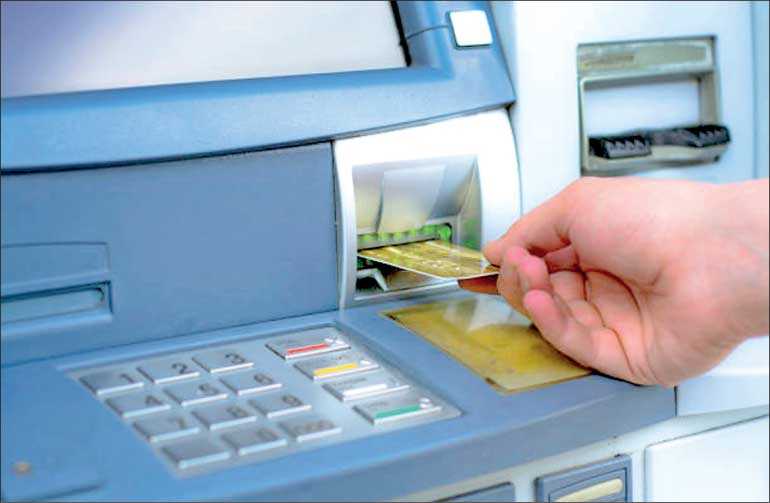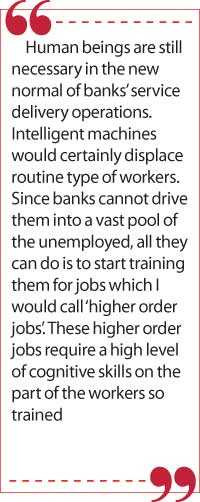Sunday Dec 15, 2024
Sunday Dec 15, 2024
Monday, 15 June 2020 00:22 - - {{hitsCtrl.values.hits}}

Traditionally, it is relatively younger generations that had been prompt to accepting new technology-driven banking services. But today, COVID-19 has changed it
A salutary development of luring bank customers to technology
Last week, I was contacted by the ‘digital man’ in my bank. That was the first time that my bank had had any communication with me at least for three years. He wanted to know whether I was using the bank’s internet banking facilities. He gave me a detailed list of new benefits that I would get if I rely on the internet for banking instead of visiting bank branches in person. 
In parting, he gave me an email contact in the bank to get more details of its internet banking facilities. In my view, it was a call out of desperation and it was a good sign. Banks are taking proactive action to reshape their retail service delivery to customers in the post-COVID-19 era, characterised by a long physical and social distancing and adherence to an array of prohibitive healthcare requirements.
APB has canvassed for going for technology by banks
Thus, the message coming from Sri Lanka’s commercial banks is loud and clear: Don’t come to us and, instead, get our services from a distance. This need not have happened only after the world had been struck by an unanticipated global pandemic. If the country’s banks had followed the warning and foresighted advice of the Association of Professional Bankers or APB, of which they all are members, for the last 10 years or so, the need for detailing a digital man to lure customers would not have arisen.
At every annual session of APB for the last 10 years, the theme was the onset of technology and how banks should prepare themselves for reaping benefits out of it. Every annual session of APB is followed by a volume containing papers by experts in the subject how banks should plan in advance for embracing technology to have a wider outreach at a lower cost. Now one good thing COVID-19 has done is that banks have been forced to fast-track it.
Challenges faced by banks in the new normal of post-COVID-19 operations
Banks are facing two challenges today. One is that they have to ready themselves to experience a massive revenue loss accompanied by reduced profit levels. This is a global hazard and not confined only to Sri Lanka. The McKinsey Institute in a recent research paper has put the loss in revenue in banks in Western Europe due to COVID-19 health crisis at a wide range of 16 to 44% (available at: https://www.mckinsey.com/industries/financial-services/our-insights/reshaping-retail-banking-for-the-next-normal?cid=other-eml-alt-mip-mck&hlkid=985e1b0e260f4a1a863fc2e719414ab5&hctky=9136652&hdpid=358b1c34-e225-46db-ac0c-d3eae799385c).
Irony of bank branches
Most of Sri Lanka’s banks which have reported the first quarter financial results in 2020 have been jubilant over the record profit levels they have earned in the quarter. They are in most cases an improvement over the profits they had made in the first quarter of 2019. Given the current gloomy business environment, in my view, they have been too quick to congratulate themselves on this count. That is because it is unlikely that the oncoming quarters in the year would favour them with such high profits.
The other is that, despite a visible change in the customer preference for digital banking services, bankers as well as regulators are not yet ready to change their mindset to go for digital banking at full speed. In Sri Lanka, a bank branch is still a centre of attraction for banks, local politicians and community members. When a bank moves to a certain locality, it is regarded as a blessing to the community. From the bank’s point, it enables it to have a wider outreach. From the community’s point, it helps them to explore new economic opportunities which have not been available before. From the point of regulators, it is a move in the right direction because it helps them to offer banking to all, a goal now known as inclusive banking.
 |
 |
 |
Hence, a bank branch can be opened, but cannot be closed. As such, bank managements are now in a quandary. They want to embrace new technology to keep in line with the new normal in social and physical distancing. At the same time, they have to maintain the branch network as well.
Technology can deliver inclusive banking
But the choice is not that difficult. If a branch is to be maintained for the purpose of offering inclusive banking to people, it can be attained through modern information and communication technology as well. Imagine you are in a foreign country and you want to open a letter of credit with a Sri Lankan bank to import a car. LC negotiation, submission of documentation, transfer of funds from your account to the bank which opens the LC, if funds are not sufficient, raising a loan and all other requirements can be fulfilled through internet. Since digital signatures are now accepted, the LC can be authenticated by signing it digitally. There is no necessity to have a branch of the local bank in the country you live.
Technology allows you to obtain the full range of the complex services that are involved in the opening of an LC. Similarly, the goal of inclusive banking can be attained without a physical branch on site if the bank chooses to offer its services using novel techniques. Indian banks have gone very far in this direction through mobile phone banking. The type of the mobile phone used is not a smart phone in today’s sense but an ordinary phone which can receive both voice and text messages. The bank has its own mobile phone app which is installed in the phone.
The customer can obtain the normal range of bank services such as loan negotiation, collecting the proceeds of the loan, repayment of loan instalments, opening of accounts, making deposits in the account, and withdrawal of funds from the account. In addition, credit advice can also be delivered through mobile phone banking. In this way, a bank can provide a better service from a distance with a lesser number of branches. This is an option which should be considered positively by Sri Lanka’s banks.
Resorting to internet or phone banking
The COVID-19 health crisis that led national governments to lock down their economies for prolonged periods made bank branches or their ATM systems inaccessible to customers. There were certain payments which they had to make on time irrespective of whether they could have access to bank branches or not. In those cases, internet banking facilities came in handy. As a result, even those who had not been accustomed to internet banking were forced to use it as a mere necessity.
The banks too on their part realised that they could have got customers to use those facilities to overcome the physical problems they had faced. Hence, the necessity on both sides has now made internet banking the new normal in banking. What this means is that even after COVID-19 pandemic has been brought under control, this new normal could be practised by banks as the main gateway of service delivery.
Banks had been in the forefront of using technology
But this is not an entirely new development. When new technologies were introduced in information and communication fields, banks had been in the forefront of adopting them to cut costs and reach out to customers.
Globally, they have gone into a number of technological advancements in the last few decades. They include branchless and virtual banking, internet and mobile phone banking, adoption of advanced, speedy and secure payment systems, offering customised services to meet their specific preferences and making their services transparent through technologies like Blockchain technology. The phase of these processes took root at first in advanced countries. But now, due to sheer necessity aroused by COVID-19 health crisis, banks in emerging economies like that of Sri Lanka cannot ignore these global developments.
The new bank in post-COVID-19 era
A bank in the forthcoming decade will be different from a bank today. The McKinsey Institute in its report quoted above has identified some of the major changes that would be introduced to global banking. Traditionally, it is relatively younger generations that had been prompt to accepting new technology-driven banking services. But today, COVID-19 has changed it.
According to McKinsey Institute, bank customers in older groups representing those of above 50 years have been using internet and mobile phone banking in the same tempo as the young people to obtain simple and day to day services. It is only for complex and ad hoc banking services that they had faltered. But even the young people have been aversive to receiving those services through internet or mobile phone banking. In addition, customers across all the ages have been relatively reluctant to visit bank branches in person implying that it would be the new normal service delivery by banks even after the effective resolution of the COVID-19 pandemic. What is to be done by banks is to make this digital service delivery their default delivery system.
Bank branches are still there
In the new banking era, bank branches would not disappear completely. This is because they still have a role to play in providing complex and ad hoc banking services. As mentioned above, bank customers of all ages would use internet or mobile phone banking increasingly for simple and routine type banking services.
Hence, bank branches have to focus on providing the complex banking service needs of customers by developing their staff specifically fit to attend to them. In this environment, the present services provided by bank tellers behind counters could be handed to intelligent ATMs and banking kiosks set up in different localities. Intelligent ATMs are kiosks with functionalities beyond basic services. Some of the services presently provided are video-banking facilities through which the customers can communicate with bank officials as if they have met them in person and the adoption of remote teller technology to rapidly dispense their cash requirements.
Such banking is without contact with bank officials supported by card-less withdrawal of cash. These intelligent ATMs also facilitate interaction between the customer and the online systems that have been connected to bank’s ecosystems speedily and securely.
The disappearance of routine type jobs
Thus, in the new normal of banking, most of the routine jobs that are presently handled by staff will disappear. These jobs will be taken over by intelligent machines. These machines are capable of handling currency management functions, opening of accounts and acceptance of deposits, loan application processing and above all, retrieving, collating, analysing and cataloguing a vast array of data which humans are unable to handle.
A new software developed by J P Morgan Chase, called COIN that stands for Contract Intelligence, is reported to have processed some legal cases within seconds which its legal team would have taken more than 360,000 man-hours to accomplish (available at: https://www.bloomberg.com/news/articles/2017-02-28/jpmorgan-marshals-an-army-of-developers-to-automate-high-finance).
COIN has helped this financial services giant to automate the time-consuming, mundane and prone to frauds and errors job of scouring hundreds and thousands of legal cases and prepare briefs for use by its lawyers in courts of law. Accordingly, lawyers are not displaced. The unpleasant job involved is completed by machines and the more intelligent work is still handled by human beings.
Humans should be masters and not servants of intelligent machines
What this means is that human beings are still necessary in the new normal of banks’ service delivery operations. Intelligent machines would certainly displace routine type of workers. Since banks cannot drive them into a vast pool of the unemployed, all they can do is to start training them for jobs which I would call ‘higher order jobs’. These higher order jobs require a high level of cognitive skills on the part of the workers so trained.
A worker versed in cognitive skills is capable of maintaining a good memory and learn, process and infer on new information. A worker high in these skills will be placed in commanding heights of work-related operations with capability to program and direct intelligent machines. In other words, the bosses in banks are still human beings and not intelligent machines.
However, human beings have to acquire these qualities through rigorous training and learning done on a continuous basis. It is in the interest of banks to create such a learning environment within their organisations. It is also in the interest of bank officials to place themselves on such a learning path and emerge as masters and not servants of the intelligent machines used in banks. This is similar to the use of email today. Email is only a servant as long as it is intelligently managed by its master. The moment the master loses control, emails can cause havoc to its user.
This is a fine lesson which bank officers should take note of.
(The writer, a former Deputy Governor of the Central Bank of Sri Lanka, can be reached at [email protected].)